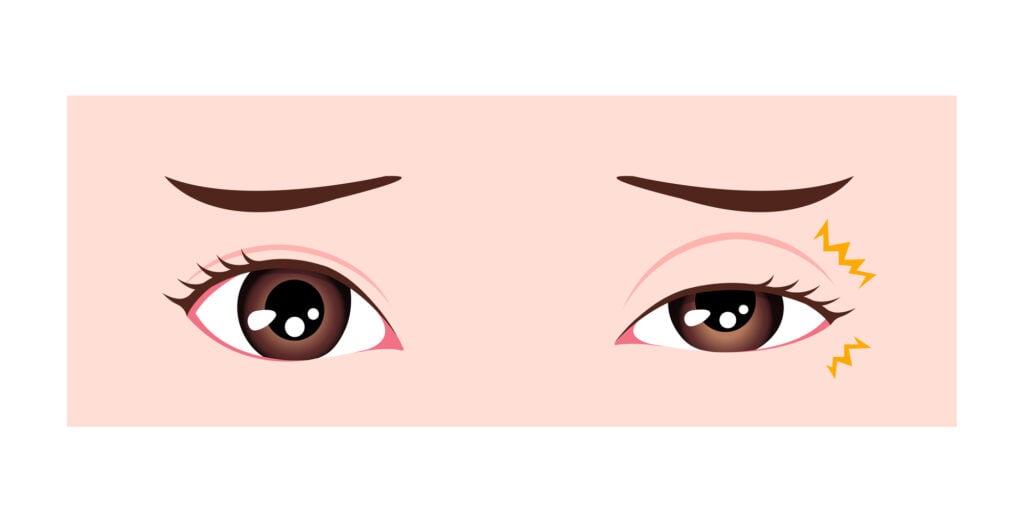Many people experience occasional eye twitching. Also known as myokymia, eyelid twitches usually aren’t a cause for concern.

Eye twitching is usually caused by muscle spasms related to stress, eye strain, or dry eyes. Severe eye twitches that persist for a long time may indicate an underlying medical condition.
Most eye twitches go away on their own. Fortunately, you can take steps to stop eye twitching and prevent it from happening. You may need to see a doctor for medical treatment if you have chronic eyelid twitching.
Common Causes of Eye Twitching (Eyelid Spasms)
The exact cause of eyelid myokymia is unknown and might vary from person to person. Some people notice an increase in twitching when they are experiencing stress.
Other causes of eye twitching include:
- Wearing contact lenses that are scratched or unclean
- Eye irritation from allergies, wind, air pollution, etc.
- Corneal abrasion
- Dry eye
- Excess caffeine intake
- Fatigue or lack of sleep
- Light sensitivity
- Consumption of alcohol
- Smoking
Looking at a computer or other screen for prolonged periods can cause digital eye strain, which can increase twitching.
How to Stop Eye Twitching
For many people, the best treatment for eye twitching is to prevent it from occurring. There are several things you can do to reduce twitching, many of which offer additional benefits.
The most common options for preventing eye twitching include:
- Taking measures to keep stress under control
- Limiting screen time and other activities that cause eye strain
- Taking frequent breaks when working with a computer
- Getting enough sleep to allow eye muscles to relax
- Limiting caffeine intake
- Engaging in relaxation techniques such as yoga, breathing exercises, or meditation
- Moisturize dry eyes with eye drops
The most effective way to prevent or reduce eye spasms varies based on the cause.
When to See a Doctor for Eye Twitching
A minor eyelid twitch that lasts a short time typically isn’t a cause for concern. Eyelid twitching that doesn’t go away and is accompanied by other symptoms may need medical attention.
See an eye doctor whenever eye twitching interferes with sleep or daily activities. Treatment is available, so there is no reason eye twitching should affect your quality of life.
Contact your doctor if you experience eye twitching that:
- Lasts more than a few weeks
- Causes your eyelid to close or affects your vision
- Spreads to other areas of your face
- Causes discharge or tearing
- Causes swelling or redness around your eye
- Develops into eyelid drooping
Treatment for Eye Twitching
Temporary eye twitching usually doesn’t require treatment. If eyelid twitching interferes with your quality of life, affects your vision, or is chronic, treatment is necessary.
Lifestyle Changes
Sometimes, treatment includes only lifestyle changes, such as:
- Reducing screen time
- Avoiding eye strain
- Reducing stress
- Ensuring you get enough hours of sleep
Botulinum Toxin (Botox)
Botulinum toxin (Botox) prevents eyelid spasms by relaxing the facial muscles. Your doctor can inject Botox into the muscles around your eye if the twitching is chronic and uncomfortable. This paralyzes the muscles so they can no longer contract and twitch.
Surgery
For some people, eye twitching requires a surgical procedure called a myectomy. This involves removing some muscles and nerves in the eyelids.
Eye Drops
Eye drops, or artificial tears, are effective for easing twitching, especially when the condition is directly related to dry eye. Eye drops are available over the counter, but your doctor might also recommend specific types of drops if you suffer from chronic dry eyes.
What Conditions Can Make Eye Twitches Worse?
Most instances and causes of eye twitching aren’t serious. However, there are three instances in which a serious eye health condition will cause twitching.
These include:
- Hemifacial spasms (facial spasms)
- Essential blepharospasm
- Blepharitis
Benign essential blepharospasm causes involuntary movements in the eye. There is no known cause, but researchers believe it is linked to a malfunction of basal ganglia, which are cells in the nervous system.
Eye twitching isn’t a symptom of an eye disease but a sign of a brain or nervous system disorder. It is rarely the only symptom a person experiences when this is the case.
Eye twitching has also been linked to the following serious conditions:
- Bell’s palsy
- Dystonia
- Cervical dystonia
- Multiple sclerosis
- Parkinson’s disease
- Tourette syndrome
- Oromandibular dystonia and facial dystonia
- Chronic movement disorder
Some people diagnosed with Parkinson’s disease experience eye twitching as a side effect of the medication used to treat their primary nerve disorder.
Complications of Eyelid Twitching
Complications of eye twitching only occur in rare cases. It tends to be a temporary, highly treatable, and preventable issue.
However, some people experience side effects caused by twitching, including:
- Drooping eyelids
- Double vision
- Blurred vision
- Excessive tearing
- Injury to the cornea
- Permanent eye damage
Summary
Eyelid myokymia, or eye twitching, happens when the muscles around your eyelid spasm. Temporary eye twitching usually isn’t a serious concern. If eye twitching doesn’t go away or affects your quality of life, there are things you can do to prevent or reduce it.
To stop eye twitching on your own, you can address the underlying cause, such as reducing stress or getting more sleep. Ongoing eye twitching that occurs with other symptoms, such as eyelid drooping, may be a sign of a medical condition that requires treatment.
Call your doctor if chronic eye twitching becomes bothersome or affects your daily life. Medical treatments are available.
In this article







